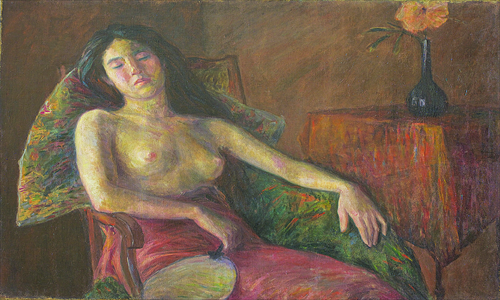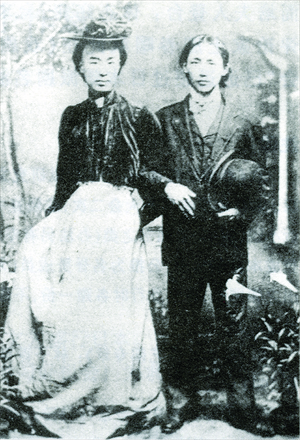Lasting Fragrance


He was a pioneer in spreading Western music in China, the first to use nude models to teach painting in China, and among the first to stage plays in China. He was a master of literature, painting, calligraphy, seal cutting and music. He also retired amid fame and success, turning to Buddhism.
He is Li Shutong (1880-1942), also known as Zen Master Hongyi, a legend, a genius and even somewhat of a myth in the history of Chinese art. And on March 1st, artistic creations from his early years went on display at the China Central Academy of Fine Arts (CAFA) Art Museum.
Fill the gap
Unlike other exhibitions of this kind, the "protagonists" of this exhibition - Long-lasting Fragrance: Study on Li Shutong's Oil Paintings - are only two works: one is A Half-naked Woman from CAFA Art Museum and the other is a self-portrait borrowed from Tokyo University of the Arts (TUA). The exhibition is a milestone because they are the only known oil paintings by Li and have been out of Chinese people's sight for more than 50 years.
A Half-naked Woman was painted by Li in 1909 when he was studying Western painting in Japan. But it changed hands several times and there was no information about its whereabouts for half a century even though it had been mentioned in many books and editorials about Chinese fine art.
It remained a mystery until 2011 when CAFA Art Museum staff member discovered it while sorting through its collection from the period of the Republic of China (1912-49). Then the museum restored the painting after meticulous examination. Wang Huangsheng, curator of the museum, regards its reappearance as a significant event in the history of Chinese culture and art.
According to Wang, the museum has been considering an exhibition since the discovery and has received support form TUA, which owns Li's self-portrait that was painted upon his graduation in 1911. This is the first time for the painting to be exhibited in China.
Records show that in 1918, Li would mail his oil paintings to the Beijing School of Fine Art (precursor of CAFA) before becoming a Buddhist monk, but they were lost around the 1920s or 1930s. Among them is one named Flowers, which is supposedly in Singapore, but "no one has seen the picture personally yet," Wang said. The scarcity explains why the meeting of the two remaining paintings is so significant.
Renaissance man
Entering the exhibition hall on opening day, one could hear Li's song "Farewell," which has been passed down for decades as a classic. The hall was full of people drawn by his talents and fame, ranging from college students to senior artists and experts.
Born in 1880 in Tianjin in a banking family, Li has been regarded as a Chinese Leonardo da Vinci because in many ways he is as gifted. Many say he is the only person that has condensed inside himself the essence of Chinese culture and art of the first half of 19th century.
Li demonstrated his talent in literature and calligraphy in his youth when he wrote a large number of poems that expressed concern about his country and its people. He went to study in Japan after his mother died in 1906, when he believed his "time of happiness" had passed.
He mainly studied Western painting in the Tokyo School of Fine Arts (the predecessor of TUA) and meanwhile developed interests in music, literature and theater, excelling in them all.
While studying in Tokyo, he began to have many of his works exhibited in important exhibitions, which was rare for Chinese students abroad. He is regarded as an "unforgettable predecessor for Western painting in China" because he was one of the pioneers to learn Western painting formally and was dedicated to introducing it to China. He was the first to use live models in art class in China, which is an irreplaceable contribution to Chinese oil painting and the education of fine art.
Li was also the pioneer of spreading Western music and drama in China. His song "Farewell" originated from American musician John Pond Ordway's "Dreaming of Home and Mother," for which he wrote a poem expressing the sorrow of parting. The song has been popular for decades and was used in the scores of several films.
Li also became a master of Chinese calligraphy, which he focused on after retiring from the world.
Li chose different roles in various periods of his life, all with their own splendor. But what makes him respected is not only his talent. Pan Gongkai, director of CAFA, said that "noble" is not enough to describe his virtuous character.
"We cannot stress more the importance of such a master," Wang said, "We hope the exhibition can arouse social attention and find more of his lost works."
Ceaseless cooperation
Along with Li's two oil paintings is a series of academic essays on A Half-naked Woman and some highly imitated copies of self-portraits from 1911 to 1946 painted by 40 other Chinese students in Japan provided by TUA.
Also, some letters and materials from Li's early years are on loan from the Li Shutong Birthplace Museum.
Wang told the Global Times that the various-styled self-portraits, with Li's as the representative, are testimony of the history of Chinese students who studied abroad in the late Qing Dynasty (1644-1911) and are invaluable for the study of the artists from that period.
On one wall of the exhibit is posted a directory of the Chinese students who studied at TUA. It shows they began studying there in 1905 with Li going there in 1906.
On October 4, 1906, a news report titled "Qing people dedicated to Western painting" in Japan tells what Li's school life was like and illustrates how in the late Qing Dynasty, people in Japan had begun to pay attention to this group of Chinese students.
Today, the art exchanges are ongoing. Since Li's remaining works are so few, the exhibition of Li's oil paintings is impossible without the help from TUA, which provides not only Li's but other students' self-portraits.
Seriu Haruna, an assistant professor with TUA who escorted Li's self-portrait to China for the exhibition, said that these self-portraits are well preserved through the years.
"We hope there will be deeper cooperation and communication with CAFA," Haruna said, adding that TUA is going to conduct deep analysis on the paint of Li's painting. She told Global Times that the strained Sino-Japan relationship has little affect on the ongoing cooperation.
"We have been cooperating with TUA in various aspects of art," said Wang, "Politics will not and should not affect the non-government culture and art communication."